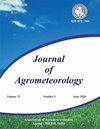Flash drought in Odisha- prediction, impact assessment, coping strategies: Current status and future strategies
Q3 Agricultural and Biological Sciences
引用次数: 0
Abstract
A detailed review was done on the past studies conducted by the researchers on climate change and variability, particularly for the Indian conditions having a typical monsoon climate. The short-term droughts (flash droughts) occurring due to the prolonged dry spells, heat waves, soil moisture deficits, which are caused due to the climate variability were also investigated. Accurate prediction techniques used for flash drought (FD), assessment of its impact on agriculture and farmers’ income as well as appropriate coping strategies recommended by different researchers to minimize the losses in crop yield and farmers’ income were analyzed. The total loss in crop yield was found to increase with increase in land size; however, per acre loss was higher for smaller holdings. It was observed that the resource crunch small and marginal farmers particularly belonging to SC/ST were worst sufferers due to their inability to adopt appropriate coping strategies such as: crop insurance, short duration climate resilient cultivars, low-interest loans from financial institutions etc. It was inferred that the FD needs special attention particularly for the state of Odisha, where a majority of the population are engaged in agriculture and its allied activities. Agriculture accounts for around 30 per cent of the net state domestic product (NSDP). Investigations of the past studies revealed that the western Odisha regions are most vulnerable to climate change and variability and to the FD caused by the climate variability. The small and marginal tribal farmers of western Odisha whose sole source of income is from agriculture, with low affordability, are worst affected. To cope with these natural calamities, they need to adopt coping strategies namely, going for a variety of sources of income, cultivation of short-duration climate resilient varieties, in-situ rainwater conservation and use for life-saving irrigation, crop insurance, and low interest loans as well as low-cost post-harvest techniques for the perishable crop produce etc.奥迪沙的山洪暴发干旱--预测、影响评估、应对策略:现状和未来战略
研究人员详细回顾了过去对气候变化和可变性的研究,特别是对印度典型季风气候的研究。此外,还调查了由于气候多变性造成的长期干旱、热浪、土壤水分不足而导致的短期干旱(闪旱)。分析了用于山洪暴发干旱(FD)的准确预测技术、山洪暴发干旱对农业和农民收入影响的评估,以及不同研究人员为尽量减少作物产量和农民收入损失而建议的适当应对策略。 研究发现,随着土地面积的增加,农作物总产量的损失也在增加;然而,土地面积较小的农户每英亩的损失也较高。据观察,资源紧缺的小农和边缘农户,尤其是属于在册种姓/在册部落的小农和边缘农户受害最深,因为他们无法采取适当的应对策略,如:农作物保险、短期气候适应性栽培品种、金融机构的低息贷款等。据推断,在奥迪沙邦,大部分人口都从事农业及其相关活动,因此需要特别关注家庭发展问题。农业约占该邦国内生产总值净额的 30%。对过去研究的调查显示,奥迪沙西部地区最容易受到气候变化和多变性的影响,也最容易受到气候多变性造成的干旱的影响。奥迪沙西部的部落小农和边缘农民的唯一收入来源是农业,他们的负担能力很低,受影响最严重。为了应对这些自然灾害,他们需要采取应对策略,即寻找各种收入来源、种植适应短期气候的品种、就地保护雨水并将其用于救生灌溉、作物保险、低息贷款以及易腐作物收获后的低成本技术等。
本文章由计算机程序翻译,如有差异,请以英文原文为准。
求助全文
约1分钟内获得全文
求助全文
来源期刊

Journal of Agrometeorology
农林科学-农艺学
CiteScore
1.40
自引率
0.00%
发文量
95
审稿时长
>12 weeks
期刊介绍:
The Journal of Agrometeorology (ISSN 0972-1665) , is a quarterly publication of Association of Agrometeorologists appearing in March, June, September and December. Since its beginning in 1999 till 2016, it was a half yearly publication appearing in June and December. In addition to regular issues, Association also brings out the special issues of the journal covering selected papers presented in seminar symposia organized by the Association.
 求助内容:
求助内容: 应助结果提醒方式:
应助结果提醒方式:


